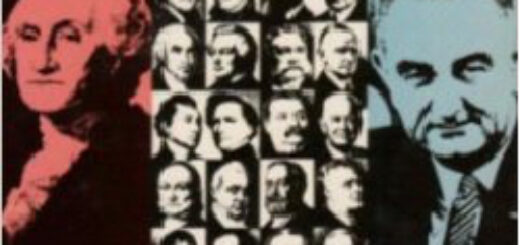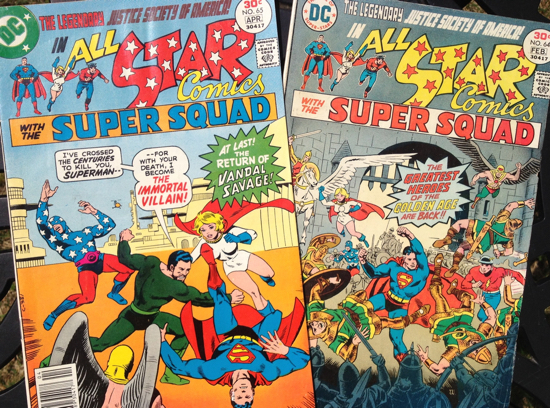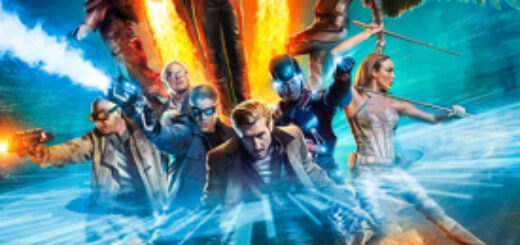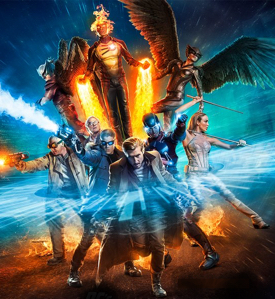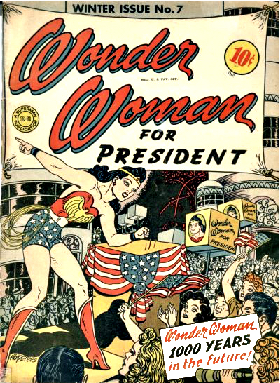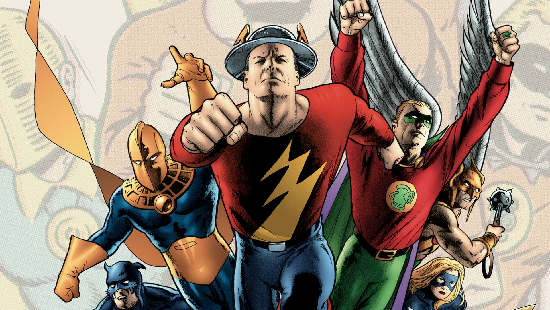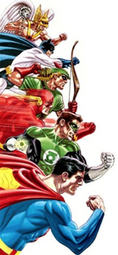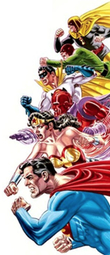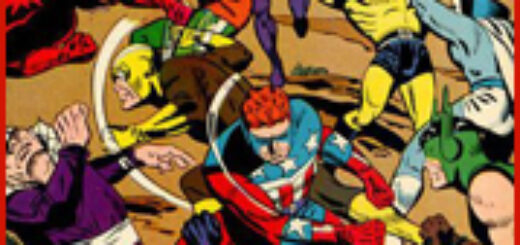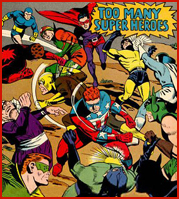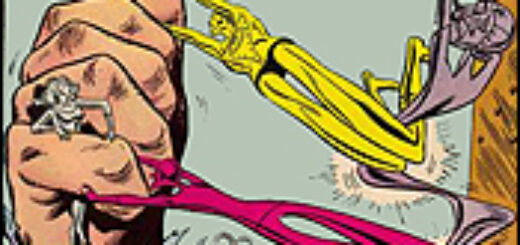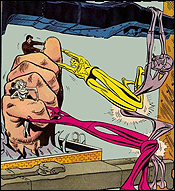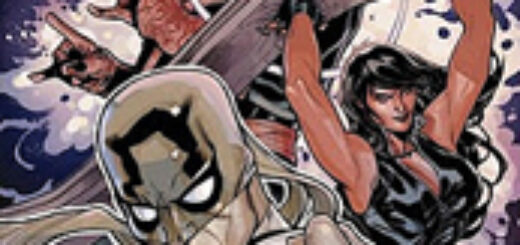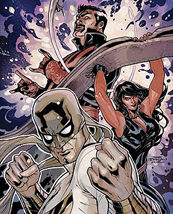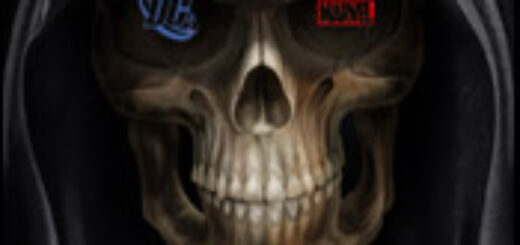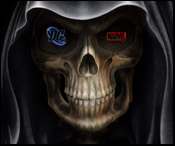Ed Catto: Respect – for the Presidents and for Geek Culture
As a kid, I had book called Our Country’s Presidents by Frank Burt Freidal. It was an important looking book published by the National Geographic Society. This heavy tome devoted a few pages to each president along with a handful of gorgeous, colorful pictures. In retrospect, the model they used was a precursor to today’s magazines, complete with sidebars and sections-within-sections.
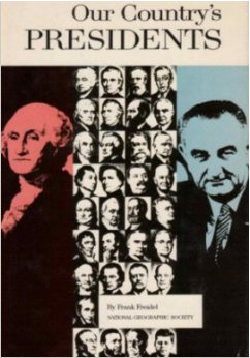 Way back when, the U.S. presidents were held in high regard.
Way back when, the U.S. presidents were held in high regard.
I didn’t think I could ever read it all, but it was great fun to skim a few chapters now and then to get a perspective on all these great men and the times in which they lived.
During that same period, as you can imagine, I was also reading a fair amount of comic books. And in one comic series, The Justice League of America, each summer they’d have an adventure with their out-of-town “relatives,” the Justice Society of America.
This made all the sense in the world to me. As an Italian-American family, we were all about gathering the family together at wonderful events. One of the leading restaurants in my hometown was founded by a relative, so getting the invite to their enormous annual summer picnic was always such fun.
Our family would just eat a lot at these gatherings. But when the Justice League of America, essentially a super hero family, would meet annually with their older, wiser, mentor-ish counterparts, the Justice Society of America, there would always be a grand adventure. Oh, sure, they’d typically have one or two pages showing all the heroes enjoying hors d’oeuvres and chatting, but that wouldn’t be very interesting for the entire story.
To help readers identify and understand the visiting characters, the comic would typically devote a couple of pages to each Justice Society member and explain a little bit about their background. To me, it seemed exactly like that U.S. presidents book. The message I got was “These old heroes are important and you should really learn about them- just like you should learn about presidents.”
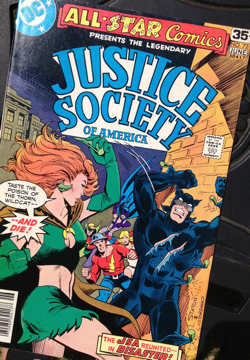 I dutifully obeyed and complied with this imagined directive. Chalk it up to the power of Geek Culture. Whenever there was an adventure with these Justice Society heroes, it was a treat for me and I took it seriously.
I dutifully obeyed and complied with this imagined directive. Chalk it up to the power of Geek Culture. Whenever there was an adventure with these Justice Society heroes, it was a treat for me and I took it seriously.
So with this background, you’ll understand how I was thrilled to find out that these “out of town” characters, the Justice Society, would return to star in their own comic. All-Star Comics #58 was published in 1976 and starred the JSA heroes.
There they were – these fantastic characters doing amazing things, presumably in the times between those family get-togethers.
For some odd distribution reason, this wasn’t available at my regular newsstand, the fabled Pauline’s News in Auburn, NY. I had to make a special trip to a specific drug store on the other side of town to get this comic. The extra effort was worth it.
There was a new character introduced in this series too. She was kind of like Supergirl, but not as demure and sweet. She was aggressive and always displayed her assertive personality.
She was also very attractive. One artist on the series was the legendary Wally Wood, who could draw anything but had a particular aptitude for rendering pretty blondes. To a 13-year-old boy, this was of great interest to me.
I’m writing about this because I’m thrilled to announce that I was given a great honor. Gemstone’s vice-president of publishing, J.C. Vaughn, asked me to contribute an article about the Justice Society revival series to this year’s Overstreet Comic Book Price Guide.
The Overstreet Guide is another of those grand summer traditions. It’s a detailed price guide to just about every comic book ever published, but it’s more than that. It’s an incredible reference detailing the history of American comics, and provides insightful historical articles and industry trends by the nation’s top comics experts.
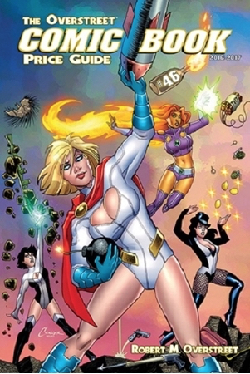 The book also celebrates creators with the annual showcase of legendary talents providing special cover artwork. This year’s cover is really special, in fact, as J.C. has recruited Amanda Conner to create a two-part diptych cover, one of which features that “pretty blonde” from my youth – Power Girl.
The book also celebrates creators with the annual showcase of legendary talents providing special cover artwork. This year’s cover is really special, in fact, as J.C. has recruited Amanda Conner to create a two-part diptych cover, one of which features that “pretty blonde” from my youth – Power Girl.
The limited edition cover is by a true master as well. Russ Heath is a phenomenal artist, whose life story is as fascinating and fun as is his art. Heath has created a moody, moving piece evocative of the old war comics covers. As usual, the Overstreet team has designed a unique alternative logo that always thrills evokes the original 60s war comics.
J.C. Vaughn treats the annual publication like one big party. As is the tradition, the book debuts at San Diego Comic-Con and then is on sale nationwide at comic shops and traditional bookstores.
Writing my article for The Overstreet Comic Book Price Guide was such fun. I talked with creators of the series, young pups just starting out when the series was first published: Paul Levitz and Joe Staton. Each has gone on to establish incredible careers in the industry. I also spoke with Justice Society expert Roy Thomas. Although he wasn’t directly involved with this iteration of the JSA, he still had great insights and revealed a story or two I hadn’t heard.
David Spurlock is the wry, charming publisher of Vanguard Productions. You may enjoy Vanguard’s fantastic books spotlighting artists like Frank Frazetta, Paul Gulacy or Wally Wood. I sure do. On the other hand, my wife just likes talking to the guy because he’s charming and witty.
But he carries the torch for many artists, and Wallace (Wally) Wood is one of them. David pulled back the curtain and revealed some great stories (some of which I couldn’t publish) about Wood’s participation in this 70s Justice Society revival.
It was great fun to write and I think it will be great fun to read! Be on the lookout and don’t be shy about reserving your copy of The 46th Annual Overstreet Comic Book Price Guide.
And if anyone has a copy of Freidel’s book on the presidents …. I’ll trade you an extra copy of the Overstreet Guide for it. I’ve got to finish reading that one!

